This website uses cookies so that we can provide you with the best user experience possible. Cookie information is stored in your browser and performs functions such as recognising you when you return to our website and helping our team to understand which sections of the website you find most interesting and useful.
section-c110228
Liquid Nitrogen
section-e990c87
Liquid Nitrogen Generators
Stirling Cryogenics
 Stirling Cryogenics is the world’s leading specialist in stand-alone cryogenic cooling systems. This is because of the success of their Stirling cryogenerator (reversed Stirling cycle based crycooler). Stirling Cryogenics developed the Stirling Cycle Cryogenerator almost 60 years ago and it has been the cornerstone of their cooling systems ever since.
Stirling Cryogenics is the world’s leading specialist in stand-alone cryogenic cooling systems. This is because of the success of their Stirling cryogenerator (reversed Stirling cycle based crycooler). Stirling Cryogenics developed the Stirling Cycle Cryogenerator almost 60 years ago and it has been the cornerstone of their cooling systems ever since.Cryomech
Cryomech was founded in 1963 by Professor William E. Gifford, the inventor of the Gifford-McMahon Cycle and the Pulse Tube Cycle.
Stirling Cryogenics
section-6ac7ac4
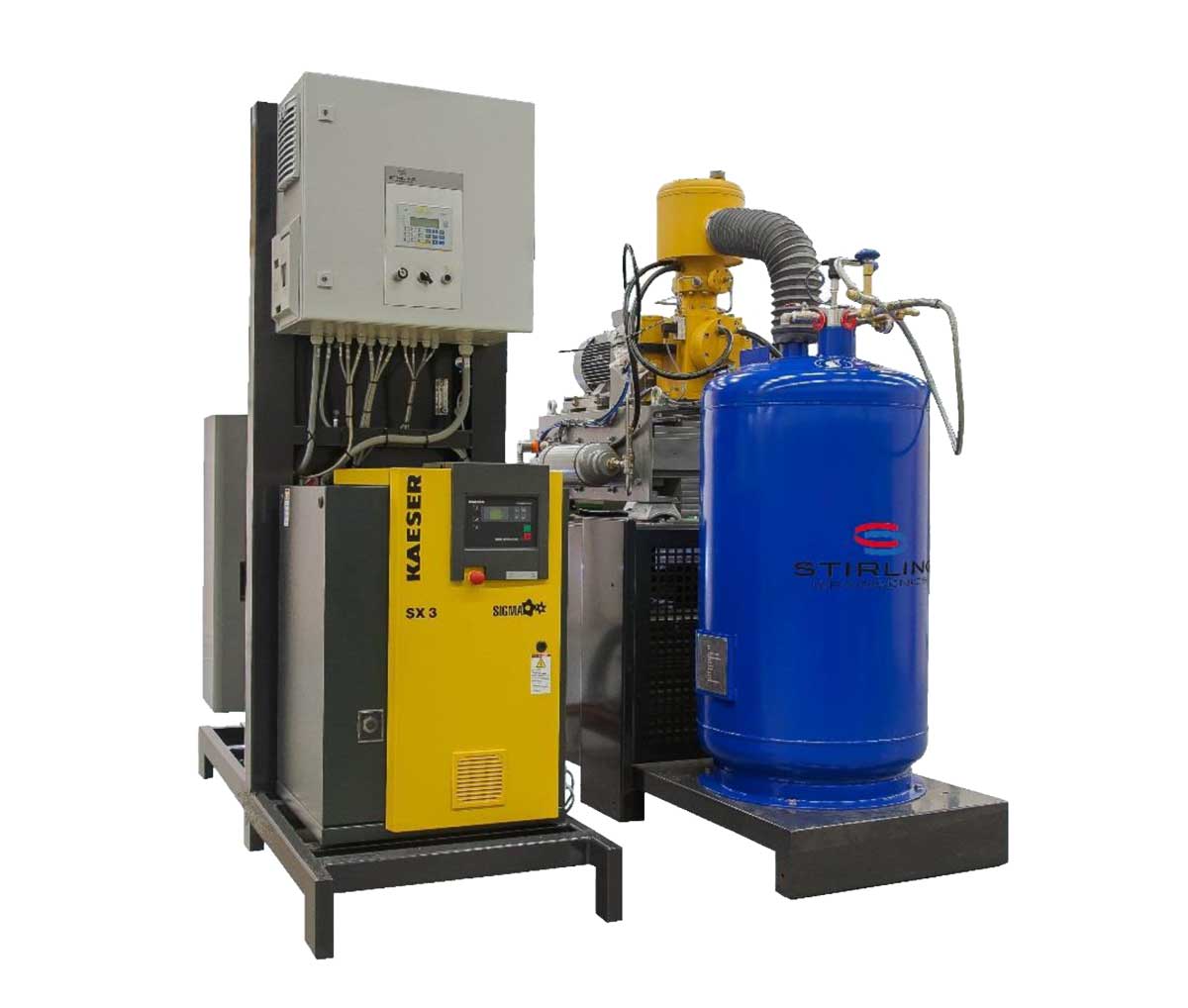
Specifications and advantages
The functionality and specifications of the StirLIN range and the advantages of StirLIN liquid nitrogen liquefaction system:
- Ease of installation
- Fully automatic operation by PLC control
- Extendible LN2 production capacity
- Adjustable liquid nitrogen pressure
- Efficient production by using the StirLIN cycle
- Easy liquid nitrogen dispensing
- Low noise level
- No Defrosting / Purging is required
- 1st drop of liquid nitrogen within 10 minutes
- Auto re-start
- Remote monitoring facility (optional)
- Built for Indian Climatic Conditions
HOW IT WORKS
How Liquid Nitrogen Generator Works
The central element in all equipment of the Stirling Cryogenics brand is the Stirling Cycle Cryogenerator. The Stirling Cycle is remarkable because it is a closed cycle in which the Cryogenerator’s internal working gas (He) never comes into contact with the fluid to be cooled; they connect only by flow of heat through the heat-exchanger wall. This concept eliminates contamination of the customers process as well as of the Stirling Cycle working gas, resulting in long continuous operating periods and longevity.
The Stirling Cycle alternately compresses and expands a fixed quantity of helium in a closed cycle. The compression takes place at room temperature to facilitate the discharge of heat caused by compression, whereas the expansion is performed at the cryogenic temperature required by the application.
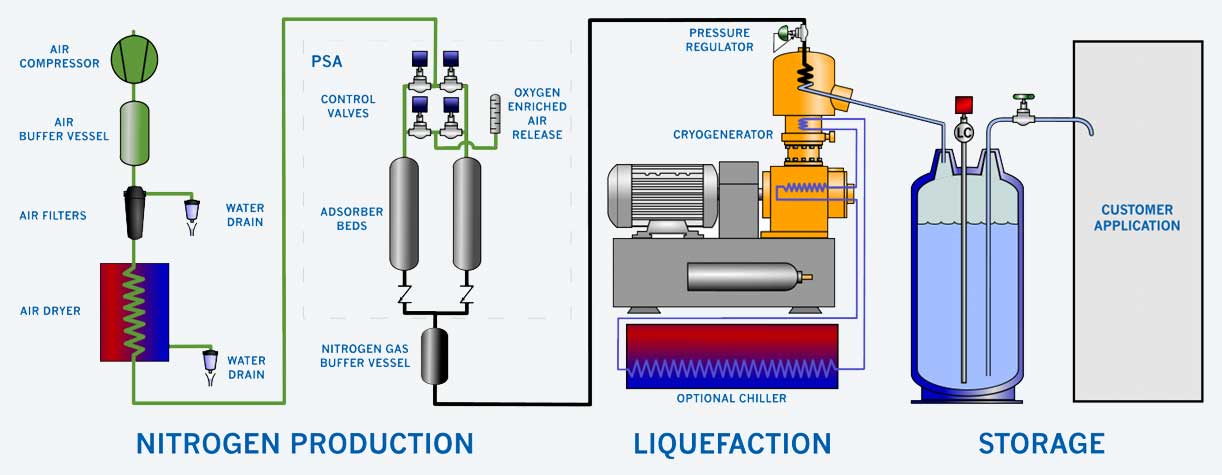
Technology History
The Stirling cycle is a thermodynamic closed cycle invented in 1816 by the Scottish minister Robert Stirling. It was used as an engine and was considered at the time to be capable of replacing the steam engine since their steam boilers were prone to life-threatening explosions. The counterpart of the Stirling engine, the refrigerator, was first recognized in 1832. Both machines experienced high and low points during the nineteenth century. The principle behind the machines was almost condemned to obscurity after the invention of the internal combustion engine (gas-, petrol-, and diesel motors) and compressor refrigerators with external evaporation.
In 1946 Philips started optimizing the Stirling cycle to be used for cryogenic cooling. The result was the development of the world conquering Stirling Cryogenerator, marking the start of significant cryogenic activities at Philips. Though the Stirling engine itself never became a commercial success, the Stirling Cryogenerator has been selling by thousands worldwide and has been incorporated in equipment and projects used from Antarctica to the North Pole.
Your own reliable cold source
With a Stirling Cryogenerator you’ve got your own reliable and efficient cold source. Stirling Cryogenics is committed to making you fully self-supporting. No longer will you be dependent on the bulk supply of liquid gas. No longer will you waste expensive evaporated gases. Simply create a cold spot in your process, liquefy the gas required or recondense coolant gas in a closed-loop system. Stirling Cryogenics always has the right cooling solution for the job and the global service network to support you.
Extreme cold anywhere, anytime
Stirling Cryogenics developed the Stirling Cycle Cryogenerator almost 60 years ago and it has been the cornerstone of our cooling systems ever since. The Stirling Cryogenerator makes it possible for our systems to produce temperatures ranging from 200 K (-75°C) down to 15 K (-258°C). Businesses, industries, hospitals and research centers all over the world rely on our expertise to provide them with a reliable, on site, supply of gases and liquids for cooling purposes. A Stirling Cryogenics cooling system is an indispensable piece of equipment in those situations where constant cryogenic cooling is crucial.
Stirling Efficiency
The Stirling Cryogenerator is extremely efficient compared to other cryogenic cooling principles Carnot efficiency is 30% at 77K, resulting in a high practical over-all efficiency defined as Watts of cooling power available to the application divided by kW of electric input power. Depending the application’s temperature, the over-all efficiency of the Stirling Cryogenerator varies between 10% for LN2 applications to over 20% for LNG systems.
MODELS
MODELS
| StirLITE | |
|---|---|
| Liquid nitrogen production | 2.9 to 3.5 Liters/hr |
| 70 to 84 Liters/day | |
| Liquid nitrogen purity | 99% at 1 bar(g) |
| System Size (l x w x h mtrs) | 2.10 x 2.30 x 2.15 |
| Storage capacity | 200L |
| Noise (dBA) | 72 |
| StirLIN-1 Economy | |
|---|---|
| Liquid nitrogen production | 5.8 to 7.0 Liters/hr |
| 140 to 168 Liters/day | |
| Liquid nitrogen purity | 99% at 1 bar(g) |
| System Size (l x w x h mtrs) | 2.10 x 2.30 x 2.15 |
| Storage capacity | 300L |
| Noise (dBA) | 72 |
| StirLIN-1 Compact & StirLIN-1 Extendible | |
|---|---|
| Liquid nitrogen production | 11.5 to 16.5 Liters/hr |
| 276 to 396 Liters/day | |
| Liquid nitrogen purity | 99% at 1 bar(g) |
| System Size (l x w x h mtrs) | Compact 2.10 x 2.30 x 2.15 |
| Extendible 3.50 x 3.50 x 1.80 | |
| Storage capacity | Compact 500L |
| Extendible 1000L | |
| Noise (dBA) | 72 |
| StirLIN-2 | |
|---|---|
| Liquid nitrogen production | 23 to 33 Liters/hr |
| 552 to 792 Liters/day | |
| Liquid nitrogen purity | 99% at 1 bar(g) |
| System Size (l x w x h mtrs) | 3.50 x 3.50 x 1.80 |
| Storage capacity | 1000L |
| Noise (dBA) | 74 |
| StirLIN-4 & StirLIN-4-Extendible | |
|---|---|
| Liquid nitrogen production | 48 to 75 Liters/hr |
| 1152 to 1800 Liters/day | |
| Liquid nitrogen purity | 99% at 1 bar(g) |
| System Size (l x w x h mtrs) | 4.90 x 3.65 x 2.00 |
| Extendible 4.90 x 4.35 x 3.00 | |
| Storage capacity | 2000L |
| Noise (dBA) | 72 |
| StirLIN-8 | |
|---|---|
| Liquid nitrogen production | 97 to 151 Liters/hr |
| 2328 to 3624 Liters/day | |
| Liquid nitrogen purity | 99% at 1 bar(g) |
| System Size (l x w x h mtrs) | 4.90 x 4.35 x 3.00 |
| Storage capacity | 2000L |
| Noise (dBA) | 74 |
Cryomech – 10 to 240 Liters/Day
section-0e8b194
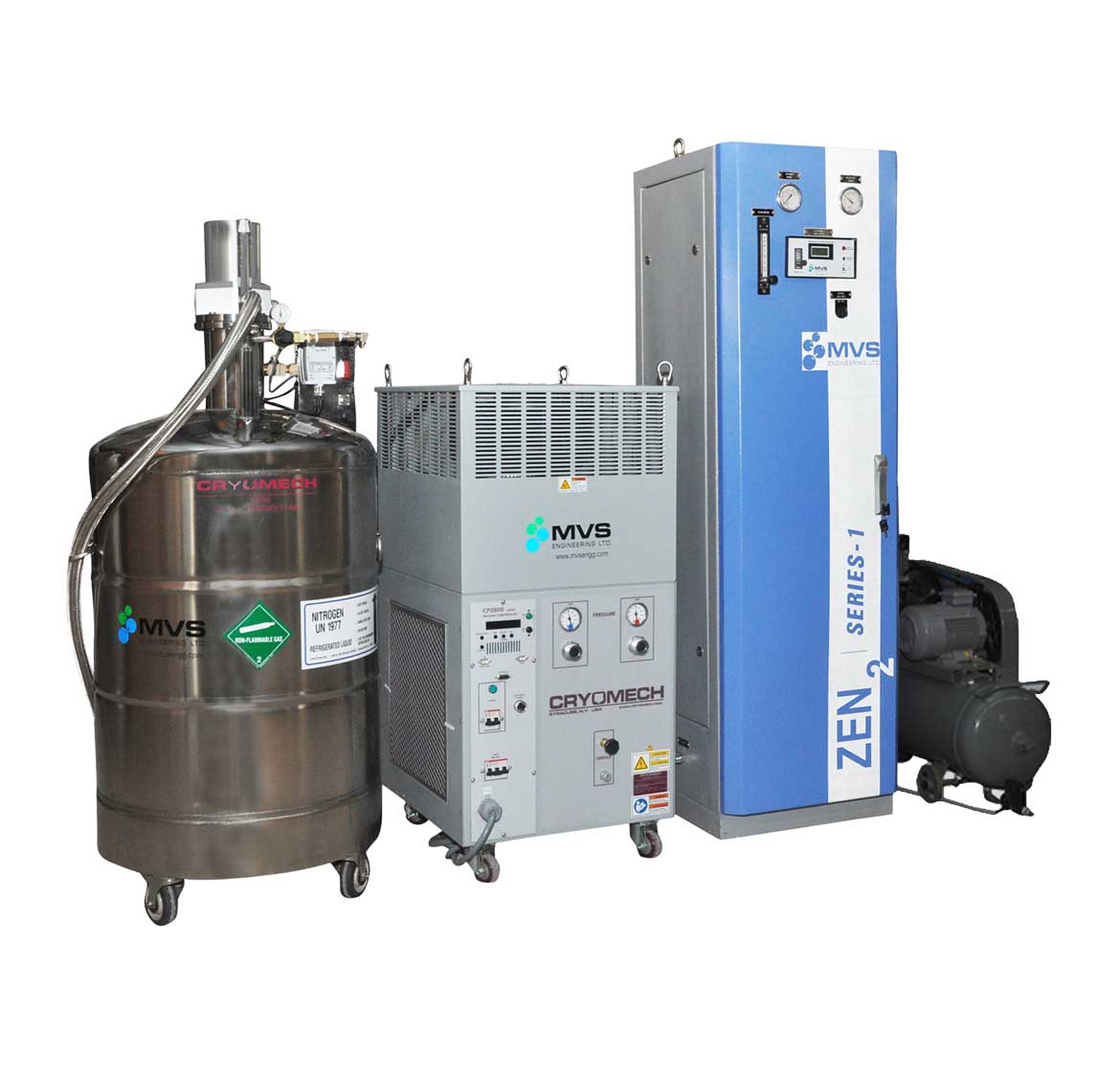

Cryomech Liquid Nitrogen Plants center their robust and versatile design on the principles of the Gifford-McMahon Cryocooler. The modular system comes fully integrated with an on-site gas generator from MVS Engineering.
At a small scale, the system is designed to be mobile and fit into most user locations, regardless of space or environmental restrictions.
Most maintenance can be performed in the field with minimal technical training. The systems are designed for long durations of use between service intervals.
Robust Features
- Cryocoolers and compressors are built at their own factory in USA
- Cryomech’s founders were the inventors of the Gifford-McMahon (GM) cycle technology
- Fully automatic operation with single push button start
- Automatically enters into standby mode when the production dewar is full
- Dewar sizes 35-500 Liters
- Cryogenically insulated extraction line and valve for low loss Liquid Nitrogen transfer
- Long operation service in between maintenance intervals
- Most maintenance can be conducted by in-house operation personnel of the client
- Long life of components with very high availability rate
- Plug and play design. In most cases, customer only needs to provide electrical power and the system can be made operational in a few hours
HOW IT WORKS
HOW IT WORKS
All Cryomech Liquid Nitrogen Plants work with exactly the same group of components.
There needs to be a supply of nitrogen gas. Nitrogen makes up 78% of the air we breathe and can be separated from the rest of air’s components. Gaseous Nitrogen is produced from systems manufactured in India by MVS Engineering.
There is a storage vessel for the LN2. A dewar is a vacuum insolated vessel designed to store very, very cold liquids.
Gaseous Nitrogen from the MVS system is taken to a cryorefrigerator to condense the nitrogen gas inside the dewar into liquid. The source of Cryomech’s expertise is in the manufacture of Cryorefrigerators (Cryocoolers). Cryorefrigerators are machines that remove heat down to temperatures below 120K (-153° C).
The Cryomech Cryorefrigerator consists of a pair of stainless steel flexible helium lines, a helium compressor package and a cold head. The cold head is installed directly at the very top of the dewar in which the liquid nitrogen is to be collected. From the top, the cold head extends to the neck of the dewar to cool down the nitrogen to 77K (-196°C) that enters the dewar. Nitrogen gas changes its state to liquid when it comes in contact with the cold head heat exchanger. The liquefied nitrogen drips down from the heat exchanger into the dewar. The pressure inside the dewar gets typically lower in this process, but the regulator lets in more nitrogen in the dewar to maintain the pressure at the predefined level. In the dewar, the flow rate of nitrogen gas is regulated by the rate of liquefaction.
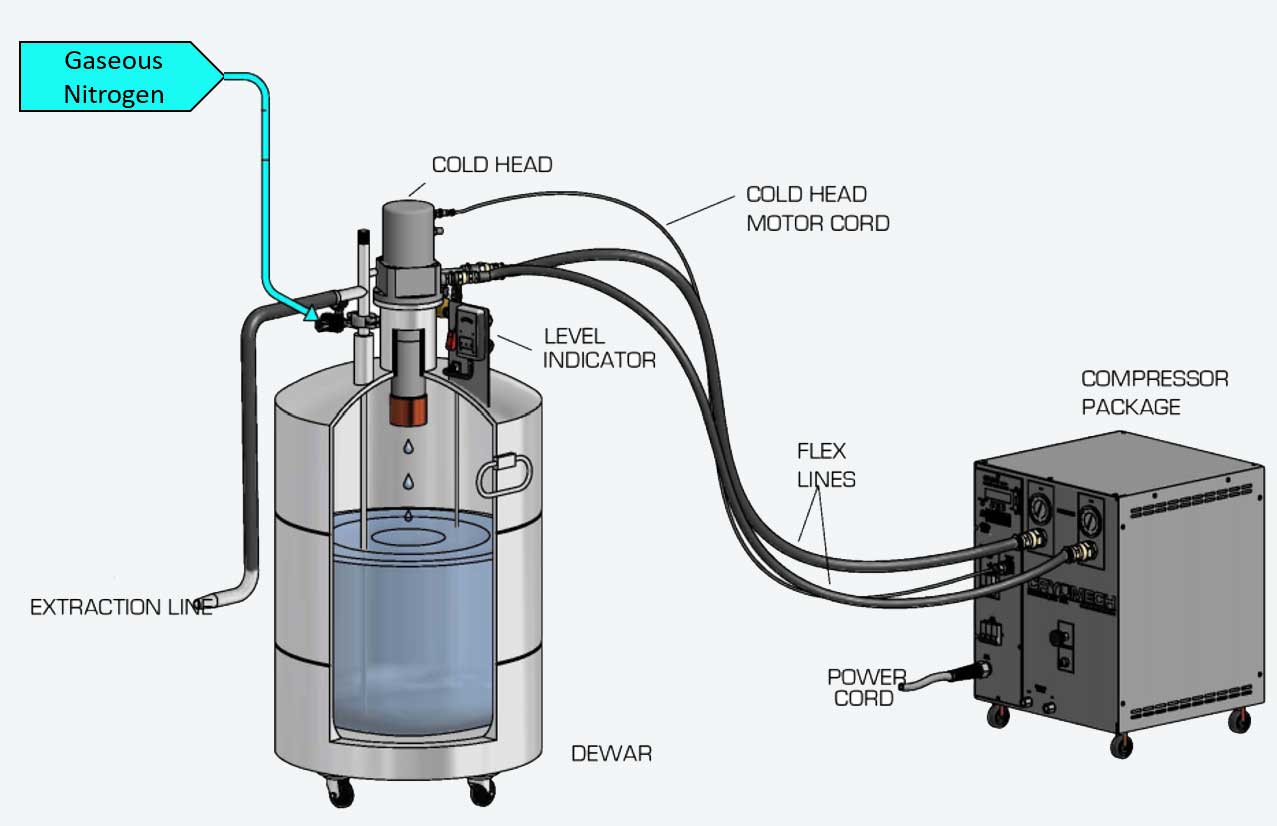
History
History
Founded in 1963 by Professor William E. Gifford, Cryomech is a world leader in compact liquid nitrogen and other cryogenic products. The founder of Cryomech is also famously known as the co-inventor of the Gifford-McMohan Cycle and the Pulse Tube Cycle. The first Liquid Nitrogen plant – the LNP40 was developed in the year 1992. Dr. Chao Wang developed the first commercially available 4K Pulse Tube Cryocooler in 1999. In 2007, Cryomech introduced the LHeP12 and 20 Liquid Helium Plants. In 2010, the first Cryomech Helium Recovery System was installed. In 2013, Cryomech developed the 1K Cryostat and released its second-generation Liquid Helium Plants with increased liquefaction rates and remote monitoring.
MODELS
MODELS
| 10 LPD | |
|---|---|
| Liquid nitrogen production | 10 Liters/day |
| Cryocooler | AL60 |
| Dewar size | 35 L |
| Helium Compressor Model | CP102 |
| Cooling | Air cooled or water cooled |
| 20 LPD | |
|---|---|
| Liquid nitrogen production | 20 Liters/day |
| Cryocooler | AL125 |
| Dewar size | 100 L |
| Helium Compressor Model | CP103 |
| Cooling | Air cooled or water cooled |
| 40 LPD | |
|---|---|
| Liquid nitrogen production | 40 Liters/day |
| Cryocooler | AL200 |
| Dewar size | 160 L |
| Helium Compressor Model | CPA2850 |
| Cooling | Air cooled or water cooled |
| 60 LPD | |
|---|---|
| Liquid nitrogen production | 60 Liters/day |
| Cryocooler | AL300 |
| Dewar size | 210 L |
| Helium Compressor Model | CPA2870 |
| Cooling | Air cooled or water cooled |
| 120 LPD | |
|---|---|
| Liquid nitrogen production | 120 Liters/day |
| Cryocooler | AL600 |
| Dewar size | 300 L |
| Helium Compressor Model | CPA1114 |
| Cooling | Water cooled |
| 240 LPD | |
|---|---|
| Liquid nitrogen production | 240 Liters/day |
| Cryocooler | AL600 x 2 |
| Dewar size | 500 L |
| Helium Compressor Model | CPA1114 x 2 |
| Cooling | Water cooled |
section-b0c4038
* These are typical specs and can be customised to match customer specific requirements
FAQ’S
Stirling Cryogenics and Cryomech Liquid Nitrogen plants are based on two different technologies and each system having it’s own set of benefits. Cryomech offers several systems for lower production rates and Stirling product range goes to very high daily production rates. Experienced sales team members of MVS Engineering will guide you with selecting the right product based on your needs.
MVS Engineering – India’s largest gaseous Nitrogen solution provider, equipped with a team of more than 150 personnel provides complete plant engineering including developing detailed data sheets, general arrangement drawings and also detailed drawings of the gaseous nitrogen system. All product data and drawings pertaining to the liquid nitrogen system comes from the OEM – Stirling Cryogenics or Cryomech. However, for customers in India, MVS Engineering is the single point of contact and we provide complete sales and support for the systems we offer.
MVS Engineering has entered into an understanding with the OEMs of liquid nitrogen plants to represent their products in India and also act as an engineering partner. Due to MVS ability to provide systems in India, MVS plays a very crucial role as an engineering partner towards the total supply of the system.
Liquid nitrogen plant consists of two main subsystems. The gaseous nitrogen production and then the cryocoolers for converting gas into liquid nitrogen. The nitrogen gas production system including air compressor, cooling system such as chiller, electrical distribution panel and control system are manufactured by MVS Engineering in India. The cryocooler is manufactured by the OEM, Storage Vessel and PLC imported by MVS and integrated into a single system for plug and play operation.
MVS Engineering provides complete sales and service for systems sold by us. We take further support of the OEM when required.
Yes, we do. Customer simply needs to provide power and utility connections at the battery limit and we take care of the rest.
Yes, absolutely. We understand that when our customers are purchasing state-of-the-art systems, they would like to see them maintained well for long-life. We offer extended warranties and AMCs for the same.
section-31e3e21
APPLICATIONS
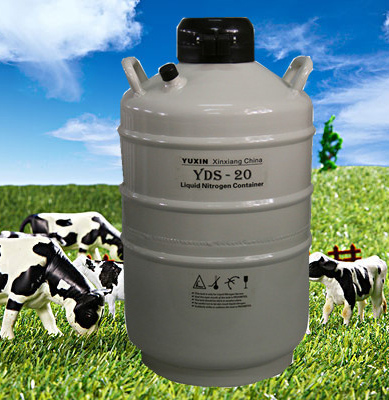 | Animal Husbandry |
| Bull semen, or other animals, after extraction needs to be preserved and requires cryo temperatures. Hence, these require a steady supply of liquid nitrogen to avoid having years of research get wasted. |
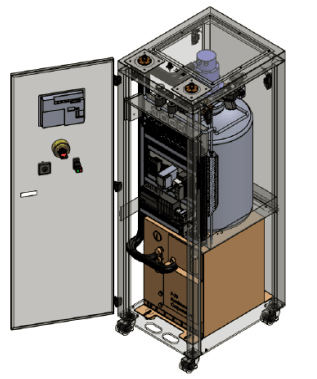 | Biostorage |
| Many samples of biological nature such as blood, ovum, semen, seeds, viruses etc. require storage and preservation which takes place at cryogenic temperatures created by our liquid nitrogen plants. |
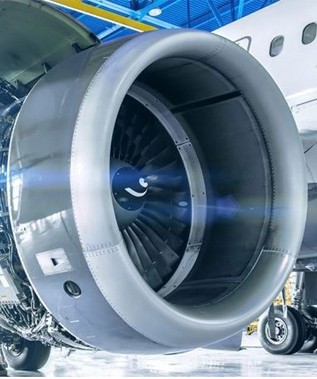 | Aerospace |
| For testing components at extreme climatic conditions, space research requires cryogenic temperatures, which can be achieved with our liquid nitrogen plants. |
 | Healthcare |
| Cooling of various instruments such as MRI magnets and research institutes require extremely low temperatures for which liquid nitrogen supply is necessary. |
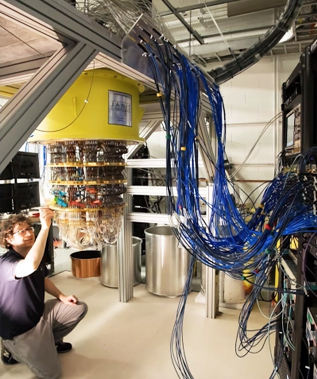 | University and Research |
| Many universities conducting research require a reliable source of liquid nitrogen for various departments. A single large system from us can produce sufficient capacity for an entire university or institute. |
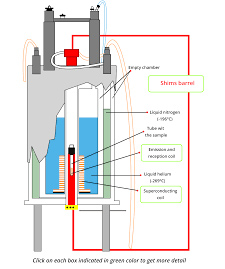 | NMR and MRI |
| Super magnets require cryogenic temperature for operation and liquid nitrogen is commonly used for the same. |

